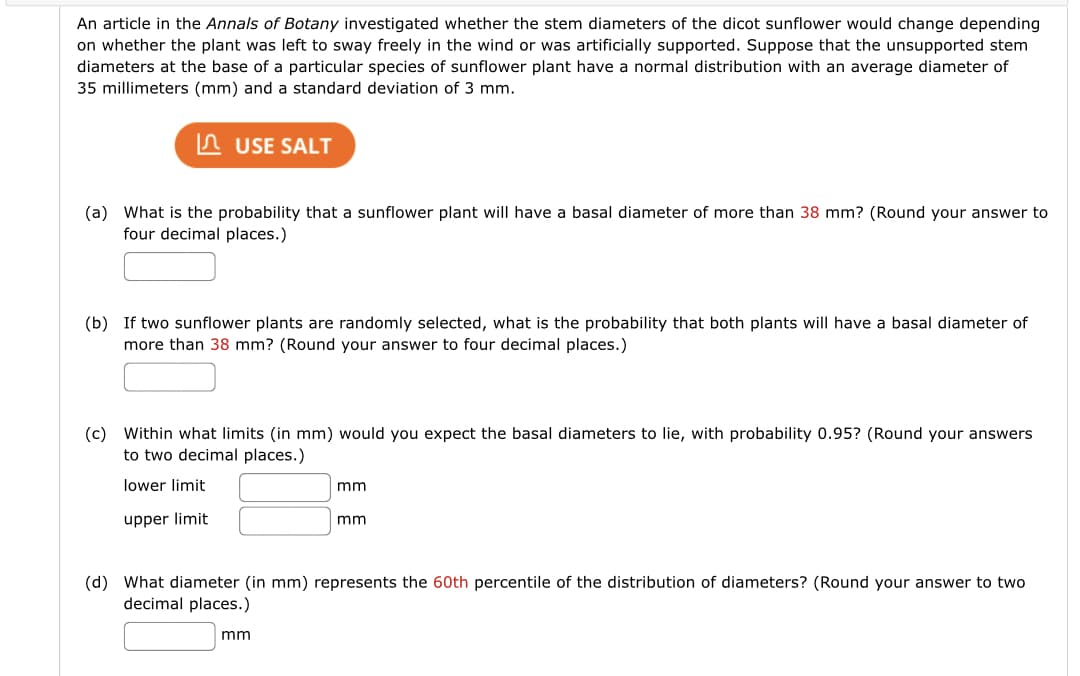An article in the Annals of Botany investigated whether the stem diameters of the dicot sunflower would change depending on whether the plant was left to sway freely in the wind or was artificially supported. Suppose that the unsupported stem diameters at the base of a particular species of sunflower plant have a normal distribution with an average diameter of 35 millimeters (mm) and a standard deviation of 3 mm. A USE SALT (a) What is the probability that a sunflower plant will have a basal diameter of more than 38 mm? (Round your answer to four decimal places.) (b) If two sunflower plants are randomly selected, what is the probability that both plants will have a basal diameter of more than 38 mm? (Round your answer to four decimal places.) (c) Within what limits (in mm) would you expect the basal diameters to lie, with probability 0.95? (Round your answers to two decimal places.) lower limit mm upper limit mm
An article in the Annals of Botany investigated whether the stem diameters of the dicot sunflower would change depending on whether the plant was left to sway freely in the wind or was artificially supported. Suppose that the unsupported stem diameters at the base of a particular species of sunflower plant have a normal distribution with an average diameter of 35 millimeters (mm) and a standard deviation of 3 mm. A USE SALT (a) What is the probability that a sunflower plant will have a basal diameter of more than 38 mm? (Round your answer to four decimal places.) (b) If two sunflower plants are randomly selected, what is the probability that both plants will have a basal diameter of more than 38 mm? (Round your answer to four decimal places.) (c) Within what limits (in mm) would you expect the basal diameters to lie, with probability 0.95? (Round your answers to two decimal places.) lower limit mm upper limit mm
Glencoe Algebra 1, Student Edition, 9780079039897, 0079039898, 2018
18th Edition
ISBN:9780079039897
Author:Carter
Publisher:Carter
Chapter10: Statistics
Section10.4: Distributions Of Data
Problem 19PFA
Related questions
Question

Transcribed Image Text:An article in the Annals of Botany investigated whether the stem diameters of the dicot sunflower would change depending
on whether the plant was left to sway freely in the wind or was artificially supported. Suppose that the unsupported stem
diameters at the base of a particular species of sunflower plant have a normal distribution with an average diameter of
35 millimeters (mm) and a standard deviation of 3 mm.
n USE SALT
(a) What is the probability that a sunflower plant will have a basal diameter of more than 38 mm? (Round your answer to
four decimal places.)
(b) If two sunflower plants are randomly selected, what is the probability that both plants will have a basal diameter of
more than 38 mm? (Round your answer to four decimal places.)
(c) Within what limits (in mm) would you expect the basal diameters to lie, with probability 0.95? (Round your answers
to two decimal places.)
lower limit
mm
upper limit
mm
(d) What diameter (in mm) represents the 60th percentile of the distribution of diameters? (Round your answer to two
decimal places.)
mm
Expert Solution
This question has been solved!
Explore an expertly crafted, step-by-step solution for a thorough understanding of key concepts.
This is a popular solution!
Trending now
This is a popular solution!
Step by step
Solved in 2 steps with 1 images

Recommended textbooks for you

Glencoe Algebra 1, Student Edition, 9780079039897…
Algebra
ISBN:
9780079039897
Author:
Carter
Publisher:
McGraw Hill

Glencoe Algebra 1, Student Edition, 9780079039897…
Algebra
ISBN:
9780079039897
Author:
Carter
Publisher:
McGraw Hill